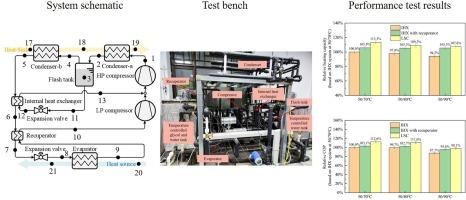Experimental investigation on a two-stage vapor compression industrial heat pump incorporating liquid separation condensation
IF 7.1
2区 工程技术
Q1 CONSTRUCTION & BUILDING TECHNOLOGY
引用次数: 0
Abstract
Industrial heat pumps are poised to play a critical role in the decarbonization of industrial thermal energy, supporting the broader transition to sustainable energy systems. Owing to their superior energy efficiency, heat pumps offer the potential to expand across various heating applications, thereby accelerating the shift toward low-carbon energy solutions.
This study presents a novel two-stage compression cycle incorporating liquid separation condensation (LSC), designed to substantially minimize thermodynamic losses associated with compression, heat exchange, and throttling processes. The proposed system integrates several advanced features, including two-stage compression, the use of zeotropic refrigerants, liquid separation condensation, and a recuperator. A prototype of the system was developed and experimentally tested. The key findings from the experimental analysis are as follows:
(1) An optimal liquid separation point was identified under the testing conditions. The most effective separation position was located at approximately one-third the length of the condenser tube from the inlet, designated as Point 2. (2) In comparison to a system employing an internal heat exchanger with a recuperator, the LSC system demonstrated a 64 kPa reduction in condensation pressure and a 148 kPa increase in evaporation pressure. (3) When the condenser-side outlet water temperature was raised from 70 °C to 90 °C, the system exhibited performance improvements, with heating capacity increasing by up to 14.3 % and the coefficient of performance (COP) rising by as much as 12.6 %.

结合液体分离冷凝的两级蒸汽压缩工业热泵实验研究
工业热泵将在工业热能脱碳中发挥关键作用,支持向可持续能源系统的更广泛过渡。由于其卓越的能源效率,热泵提供了扩展到各种加热应用的潜力,从而加速向低碳能源解决方案的转变。本研究提出了一种新型的两级压缩循环,包括液体分离冷凝(LSC),旨在最大限度地减少与压缩、热交换和节流过程相关的热力学损失。该系统集成了几个先进的功能,包括两级压缩、使用共沸制冷剂、液体分离冷凝和一个回热器。开发了该系统的原型并进行了实验测试。实验分析的主要结果如下:(1)在试验条件下,确定了最佳液分离点。最有效的分离位置位于离进口约三分之一的冷凝器管长度处,指定为点2。(2)与采用带回热器的内部热交换器的系统相比,LSC系统的冷凝压力降低了64 kPa,蒸发压力增加了148 kPa。(3)当冷凝器侧出水温度从70℃提高到90℃时,系统性能得到改善,供热能力提高14.3%,性能系数(COP)提高12.6%。
本文章由计算机程序翻译,如有差异,请以英文原文为准。
求助全文
约1分钟内获得全文
求助全文
来源期刊

Energy and Buildings
工程技术-工程:土木
CiteScore
12.70
自引率
11.90%
发文量
863
审稿时长
38 days
期刊介绍:
An international journal devoted to investigations of energy use and efficiency in buildings
Energy and Buildings is an international journal publishing articles with explicit links to energy use in buildings. The aim is to present new research results, and new proven practice aimed at reducing the energy needs of a building and improving indoor environment quality.
 求助内容:
求助内容: 应助结果提醒方式:
应助结果提醒方式:


